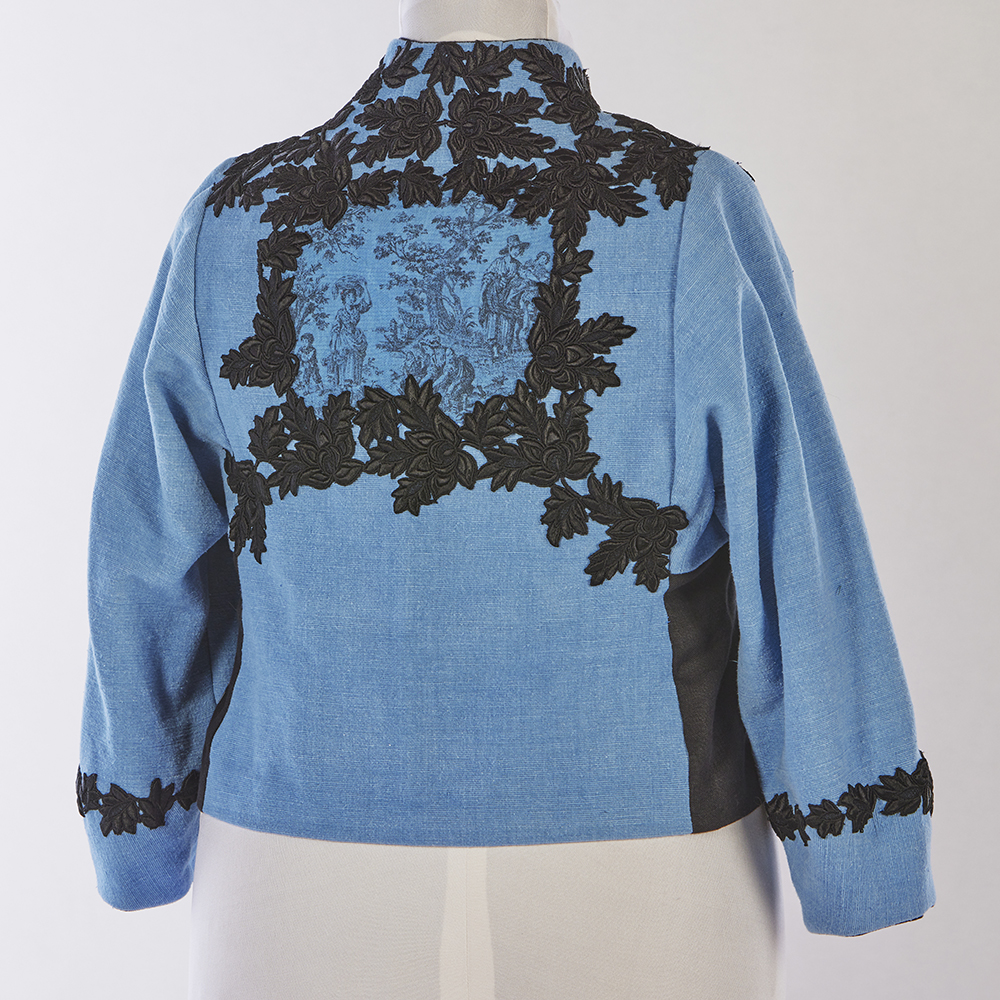
Time to get sewing friends! In this post, we will look at how I turned a precious scrap of fabric into appliqués on a cropped Funnel Neck Variation of the Tabula Rasa Jacket. The appliques were further elevated by a halo of guipure lace cut into small motifs and used to cover their raw edges. This funnel neck style variation is included in Rain or Shine Variations for the Tabula Rasa Jacket pattern. I inserted a tease about this jacket into a post last February when I wrote about transferring the round back adjustment onto this funnel neckline, so now you can read about the applique technique.

The applique fabric and the blue cotton ottoman* used for the jacket were both dyed in 2022 while we were on retreat at La Cascade. They are both beautiful examples of the plant-based pastel dye that was used in Europe before Indigo appeared on the scene. We will have a dyeing day with our Pastel expert Denise during each retreat week this year. It is really fun!
There was not much of the base fabric, so I decided to make a cropped and fitted version of my Tabula Rasa Jacket with black side panels and facings. There was even less of the toile scrap I had thrown into the dye bath just to see the results, which of course I loved, for the appliques.


Based on the scenic nature of the toile, I was able to isolate 3 appliqués—one for the upper back and one for each side of the upper front. Once I isolated the scenes, I made little paper cut outs of them and played with positioning the appliques and the available lace. This was like making a sample, a way to test the shapes and sizes before actually cutting out the fabric.

Next, on the reverse side of the toile, I edged each applique with fusible interfacing to keep them stable and avoid too much fraying out around the edges. After cutting them out, I ran a zig zag stitch all around each applique.
The appliques were positioned on the jacket after the darts and shoulder seams had been stitched in place. Then the lace was cut into small motifs and positioned all around the appliqués to cover the raw edges. I worked mostly on a flat surface but occasionally checked the shaping by hanging it on the dress form.

The lace and appliques were pinned and then hand stitched onto the jacket. The appliqués were left loose along the seam lines so the remaining construction could be completed without catching them into the seams. While this is a slow process, it is a very accurate one and makes it easy to reposition something later if it does not look quite right.

The soutache buttons were also chosen before construction was finished. I tried some others, but these buttons made with fabric braid just seemed perfect.


After the construction was complete, I evaluated the design again. There were a few lace pieces left. The sleeve looked a little stark, so the extra lace was placed along the lantern cuff seam line to add a final finish. Find the lantern cuff and summer sleeve patterns in the digital Sleeve and Cuff Variations pattern for the TRJ.

Shades of medium blue trimmed in black are so very striking, like this dress made by American Designer Anne Lowe. Carrie visited the exhibit and said this dress reminded her of my jacket. While the exhibit is now closed, there is a terrific book you can purchase through the publisher Rizzoli or other booksellers.
Come to France with Fit for Art and dye your own fabric this summer. Then you can make your own masterpiece.
Happy Sewing, RAE
- Carrie learned a new term today! “Ottoman is a widthways-ribbed textile with pronounced, raised ‘ribs’ along its wale and course.” It can be made from silk, cotton, rayon or synthetic fibers. See https://en.wikipedia.org/wiki/Ottoman_(textile) for more details.






